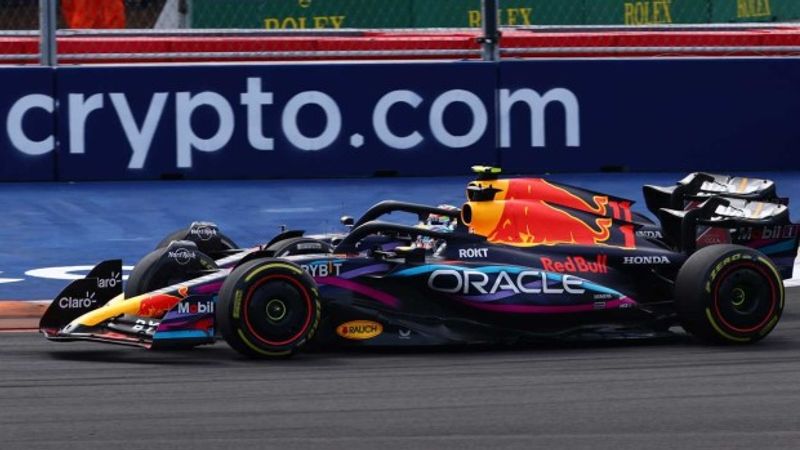In the Introduction Article, we established a few performance points where RB19 car has clear advantage over the rest of the field. The first point we’ll look in detail is Top Speed capabilities of the car, which are head and shoulders above the competition. There are a number of reasons for this and we will focus briefly on all of them:
-
very low (if not lowest) chassis drag
-
high flap camber and angle leading to relatively high drag (and downforce) of rear wing with flap down
-
both medium and low-downforce wings feature a low main plane angle for minimal drag with flap up
-
possible influence on cannon outlet pressurisation with flap up, leading to lower internal drag the best PU with the longest deployment in the field
1) Low Chassis Drag
This part is arguably debatable, however the overall consensus of the F1 Technical Experts (and also of all the Team Principals on the grid) is that the RB19 and its predecessor, the RB18, is the lowest drag chassis on the grid. There are a few key signs to it, all linked together, and we will start by excluding the rear wing from the equation - for its own individual analysis later. Tyre drag will be excluded completely from this analysis, since this is a very complex topic. However, rules for 2022 and future F1 cars require the car bodywork to be shaped in a way that has low influence on airflow around tyres - in a very convoluted technical language - so we can assume roughly the same tyre drag on all cars on the grid.
Starting at the beginning, Red Bull so far used a very shallow front wing, clearly shallower than direct competitors. While the pressure field is different on all three wings, frontal area is a big factor in overall drag, so it can be safely said that RB19 front wing is definitely not high drag and likely a low drag design.
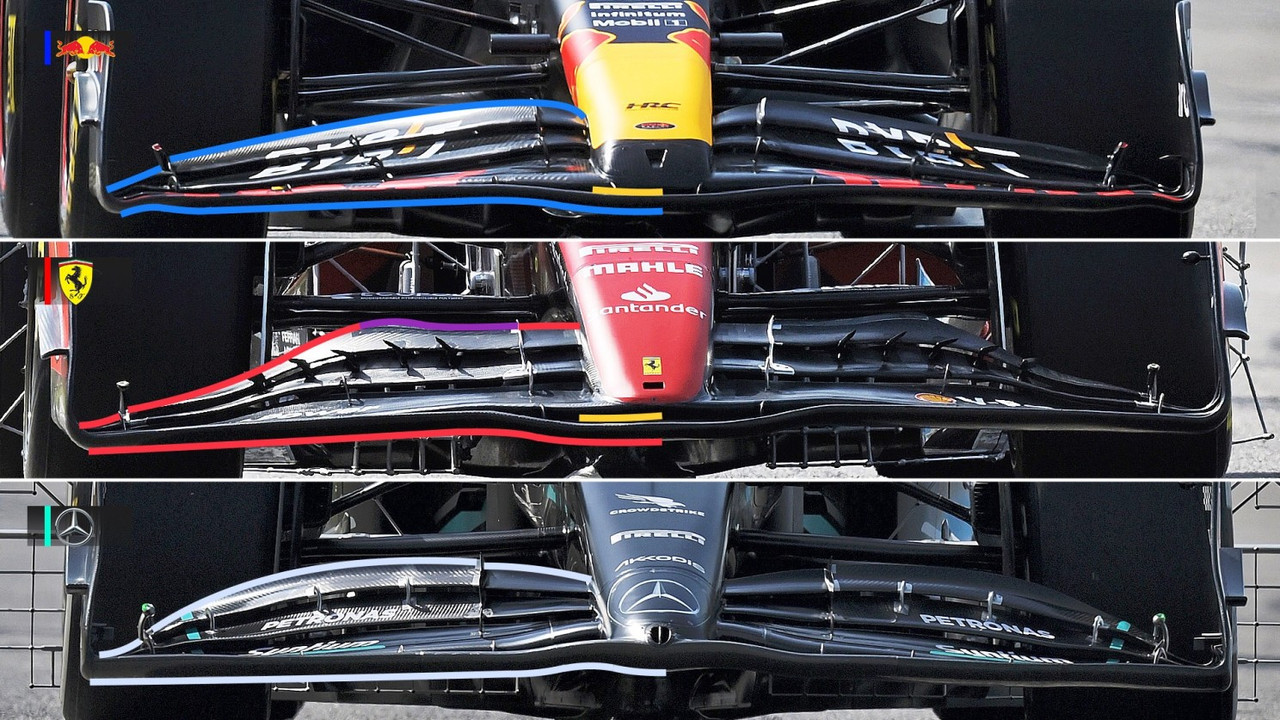
Moving on to the middle, the shape of the RB19 sidepods is an evolution of RB18 design, even tighter than before and more streamlined. Compared to Ferrari’s bulkier undercut and Mercedes’ intake that goes all the way down to the floor, it’s safe to assume RB19 generates low drag in this area
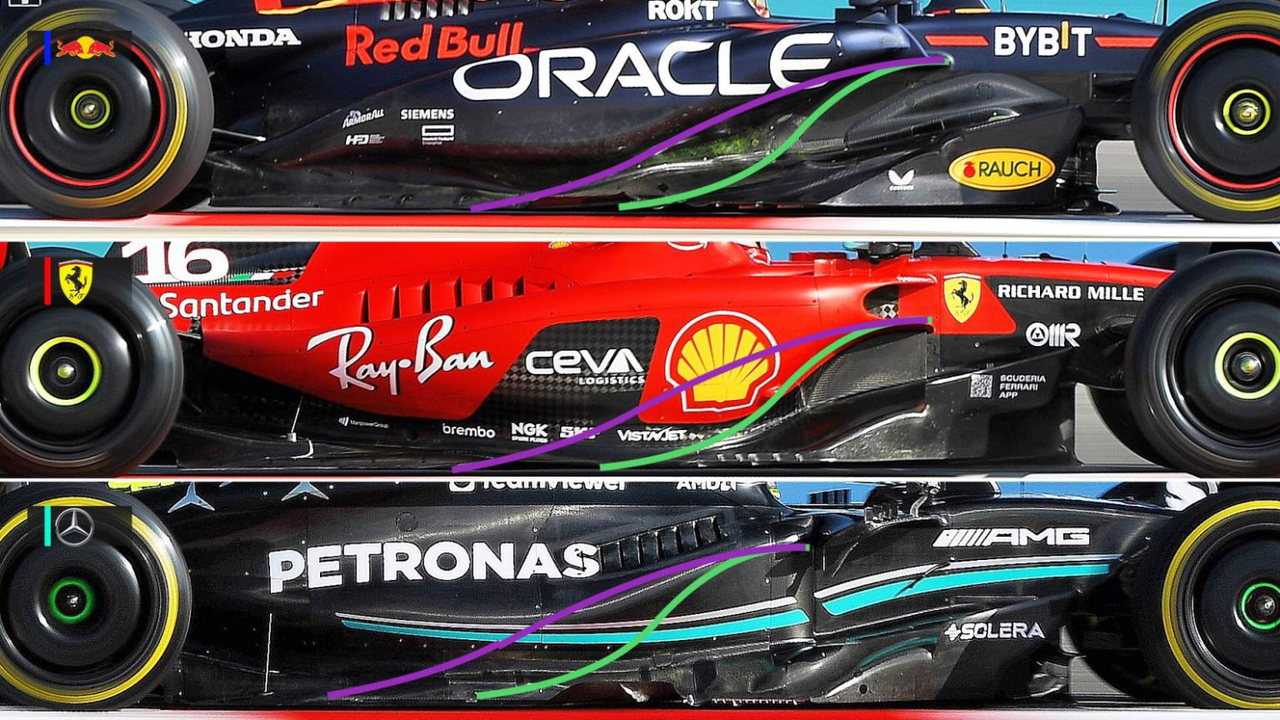
Early RB18 sidepods were analysed with CFD in a very crude, but very telling manner. The base model was provided by jjn9128 and Vyssion from F1Technical forum, while the author managed to redesign the sidepods and perform a very basic CFD case study. In the very first go, a fully streamlined flow field was achieved even if insufficiently accurate sidepod geometry was used - demonstrating a very “slippery” geometrical concept of the actual car. Other than low pressurisation at the front, there is a decent pressurisation in the rear, with transition from the sidepod slope to the diffuser ramp. Both of these aspects have a very positive impact on overall car drag.
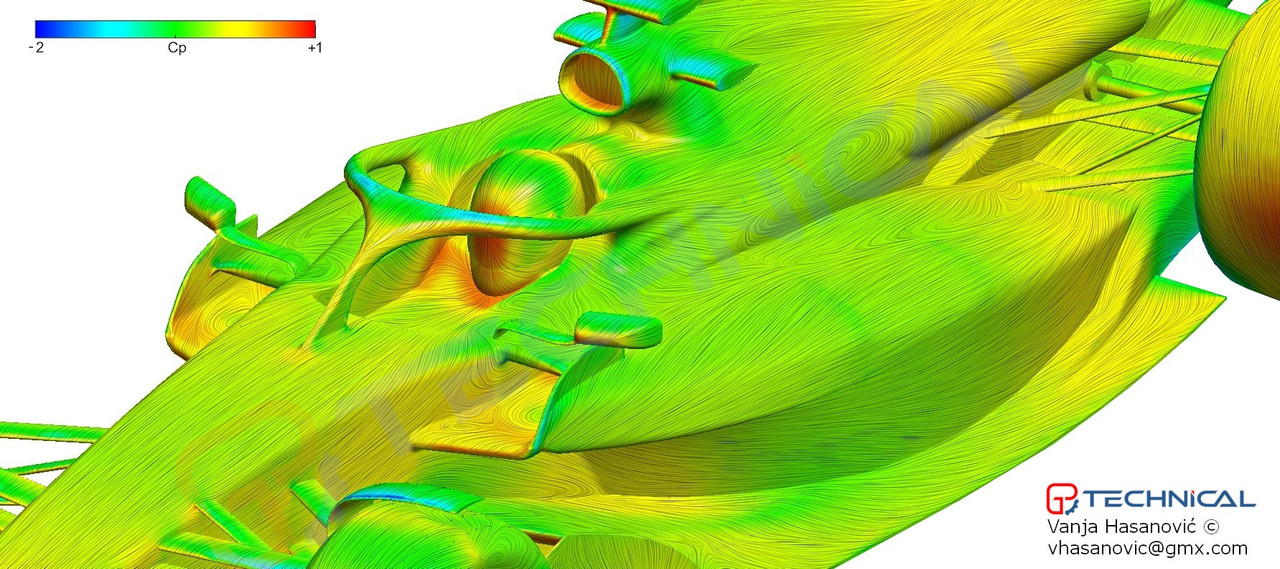
Finally, rear bodywork and engine cover designs seems to have converged in 2023, the only outliers being Ferrari and Haas cars. Those two cars have very small airbox inlets and very, very tight engine covers, meaning very low drag. However, both of these two cars have the widest sides on the grid, undoubtedly negating low engine cover drag overall. With that said, RB19 actually has the second smallest airbox on the grid, so even in this area the Red Bull team made some improvements. In conclusion - all major chassis aspects point towards very low chassis drag of RB19 car.
2) Rear Wing and DRS flap design
RB19 is hailed as a rocket on straights. However, the silent part here is - with DRS on. DRS is the Drag Reduction System, used in F1 since 2011 and introduced to aid with overtaking in the race. The reason is that the “dirty” airflow of the car ahead has a very big negative influence on the following car and overtaking is almost impossible even with huge difference in race pace. DRS consist of a moveable rear wing flap, that opens like a letter box and reduces the drag - so much, it provides up to 25-30km/h top speed increase. This is a huge number and would require roughly 25-30% more engine power (so roughly 300HP with modern F1 hybrid Power Units) to achieve without DRS. Red Bull has an especially efficient DRS design, giving them about 5, but sometimes up to 10km/h bigger top speed increase than other cars. These 5km/h don’t sound like much and on their own indeed are not in terms of lap time. In the race, however, it makes a difference between overtaking at the first opportunity and wasting lap after lap stuck behind a slower car. Needless to say, RB19 didn’t get stuck in traffic even once in 5 races so far.

For the best evaluation of DRS effectiveness, basically only Qualifying laps should be taken into account. During the race, overtaking manoeuvre includes a big slip stream speed boost (further drag reduction while following the car ahead very closely) and it tends to skew the numbers easily. Let us then compare the rear wings used by Red Bull and Ferrari in Miami GP this past weekend.
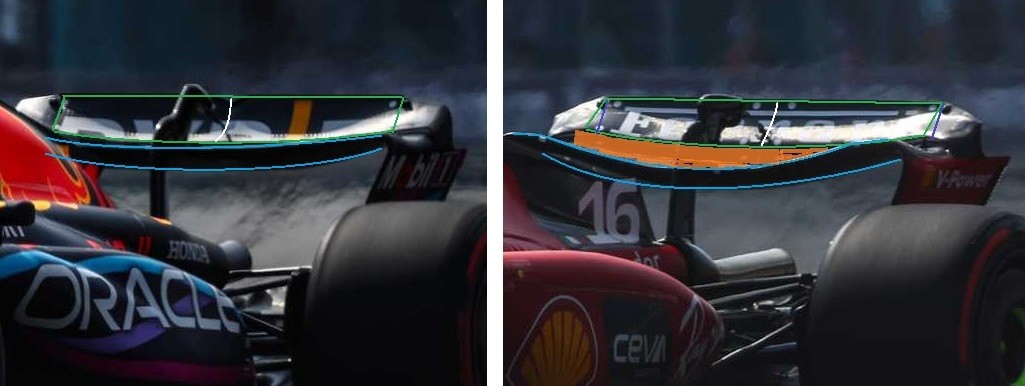
In Miami, Red Bull used a low downforce rear wing while Ferrari used a medium downforce wing and this comparison really shows the difference. Most striking part is the orange area on Ferrari wing, which is basically a central area of their scoop (blue lines) where the wing aerofoils have a big local incidence (or mounting) angle. This means this part of the wing main plane generates a good amount of downforce, but also a good amount of drag. Since the main plane is fixed, this angle is set as is and the scoop generates drag even with DRS flap up.
This is not all, however. The incidence angle of the DRS flap (green lines) and the flap frontal area - seemingly the same, but actually slightly bigger on Red Bull - are the most important factors for overall DRS effectiveness. Here, Red Bull has set the flap at a lot higher angle than Ferrari and the flap itself uses aerofoils with bigger camber (white line in the middle). All of these factors increase the downforce and drag generated by the Red Bull wing with flap down - meaning there is a lot bigger impact on drag reduction once the flap goes up. RB19 also used a medium downforce rear wing so far (in Bahrain and Australian races) and its design feature is the same as low downforce wing - the only difference is a lot bigger camber of the main plane for bigger downforce generation. So, in short - Red Bull has a rear wing design that uses an aggressive DRS flap to generate downforce with flap down, while the main plane is kept at a very low incidence angle to reduce its overall drag in all conditions. We can even safely say the RB19 rear wing design has a lot bigger drag than competitors with flap down. Why? During the race, when DRS is not active, RB19 reaches the same top speed figures as its nearest competitors. Real top speed advantage comes only with DRS flap open.
3) Rear Cooling Outlet
RB19, like RB18, features a very big rear cooling outlet located just ahead of the rear wing. This wasn’t a solution very often seen on the grid in 2022, while this year 8 out of 10 cars use this design. Only Ferrari and Haas remain committed to cooling outlets completely within sidepod louvres.
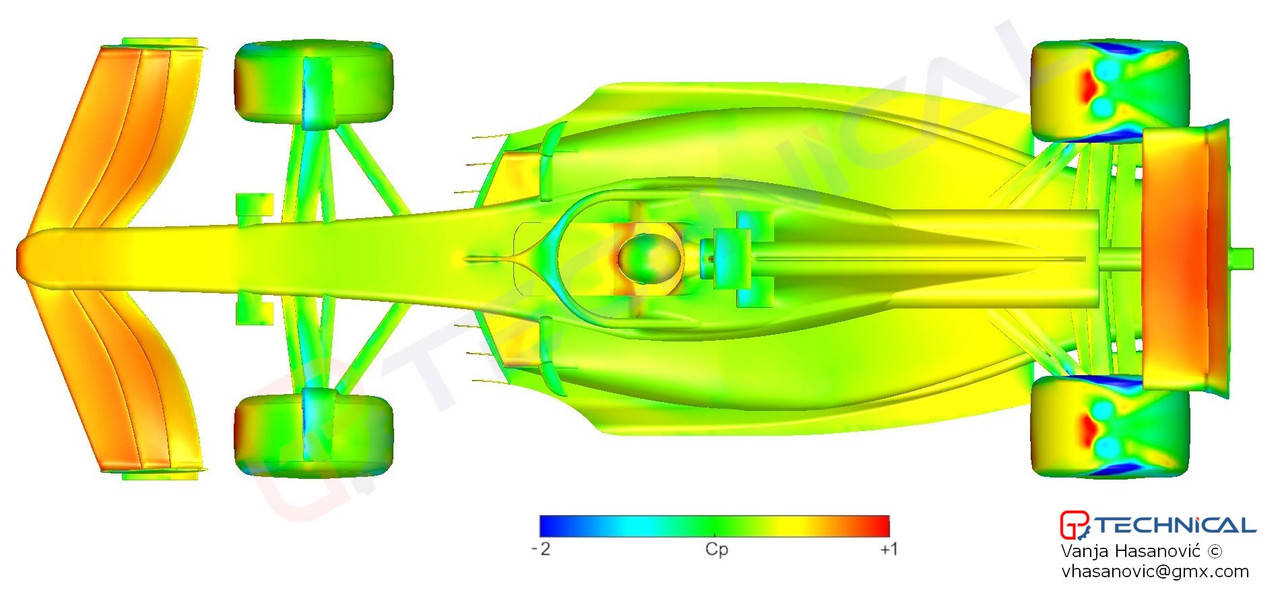
This design feature has a small effect on drag reduction when DRS flap is up. With flap down, rear wing is generating a very strong low pressure (suction) field underneath it and this pressure field propagates upstream, benefitting the cooling with the big cannon-outlet. When DRS flap opens up, suction is reduced and so the pressure within the bodywork slightly increases. This yields a small internal drag reduction, which also improves top speed.
4) The Mighty Honda Power Unit
Red Bull uses Honda PU for a few years now and has won two driver titles with it. The PU itself is an amazing piece of technology, like all four active F1 Power Units are. What makes it stand out is the ability to deploy hybrid power longer and over the course of almost entire lap than any of other competitors. This feature is best seen on Miami Qualifying graph above - Ferrari PU starts dropping down even before the driver starts to brake, while Red Bull car and Honda PU keep going all the way. This is not an essential advantage of the RB car, but it has its place in RB19 Top Speed analysis
BONUS - Myth Busting
The supremacy of Red Bull cars in top speed for second year in a row prompted many F1 technical pundits to explain this by finding trick and loopholes Red Bull might be using. The most famous one is the Triple-DRS theory. In short - the theory says that opening the DRS flap on RB19 creates a flow field that stalls the beam wing (a low rear wing above diffuser) that also stalls the diffuser for a big drag reduction.
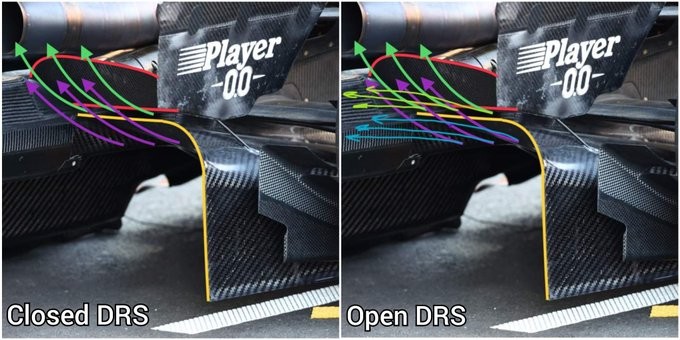
While this phenomena is possible in theory, it is almost impossible to apply it in practice:
- beam wing elements would need to be set at more than 70° with almost perpendicular trailing edge - and not a single beam wing on the grid is designed this way
2)slots between elements and diffuser itself would need to be much smaller than allowed by rules for this phenomena to occur - and FIA is taking great care not to allow moveable aerodynamic devices other than DRS
3)to operate beam wing in this “knife-edge” condition would leave it vulnerable to any flow disruption even with DRS flap closed, since it would be designed to stall at a minimal change in pressure field - and this would certainly create all sorts of havoc for the diffuser and floor while the car is cornering
Next up, we examine how the RB19 is generating so much downforce, stay tuned!
Do check out our website for more such analysis: https://www.f1dataanalytics.com/
check out our discord server: https://discord.gg/s6vcGC2G4s
Also, do follow us on Instagram and Twitter: @f1_datanalytics

About Vanja Hasanović
Loves motorsport and all things flying #AeroGimli

